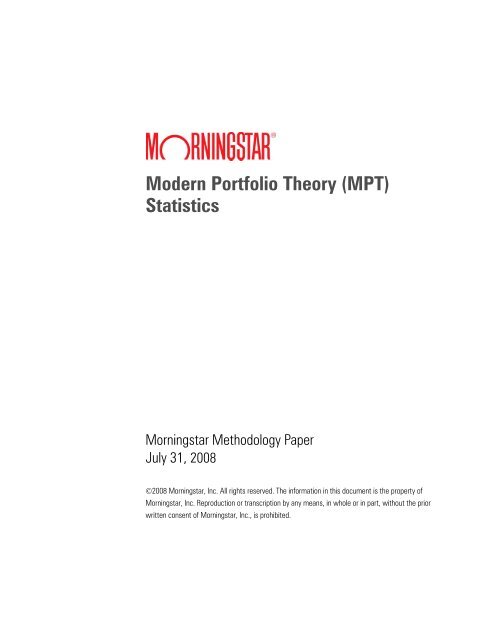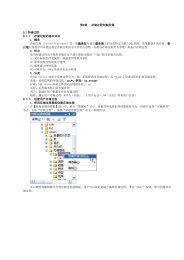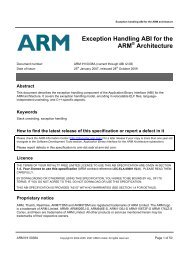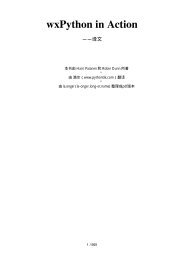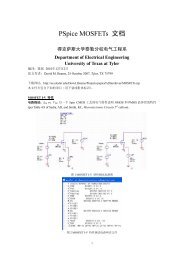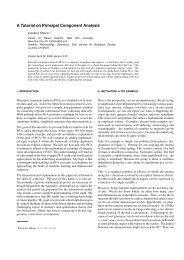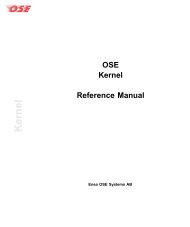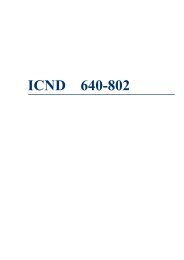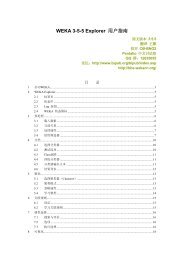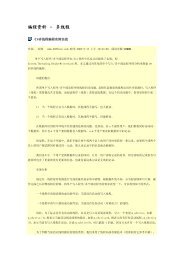Modern Portfolio Theory (MPT) Statistics
Modern Portfolio Theory (MPT) Statistics
Modern Portfolio Theory (MPT) Statistics
- No tags were found...
Create successful ePaper yourself
Turn your PDF publications into a flip-book with our unique Google optimized e-Paper software.
<strong>Modern</strong> <strong>Portfolio</strong> <strong>Theory</strong> (<strong>MPT</strong>)<br />
<strong>Statistics</strong><br />
Morningstar Methodology Paper<br />
July 31, 2008<br />
©2008 Morningstar, Inc. All rights reserved. The information in this document is the property of<br />
Morningstar, Inc. Reproduction or transcription by any means, in whole or in part, without the prior<br />
written consent of Morningstar, Inc., is prohibited.
Introduction<br />
<strong>Modern</strong> <strong>Portfolio</strong> <strong>Theory</strong> <strong>Statistics</strong> (<strong>MPT</strong> statistics) are based on the Capital Asset Pricing<br />
Model (CAPM) of expected returns developed by Nobel laureate William Sharpe and others in<br />
the early 1960s. The CAPM is based on <strong>Modern</strong> <strong>Portfolio</strong> <strong>Theory</strong> (<strong>MPT</strong>) developed in the 1950s<br />
by Sharpe’s teacher and co-laureate Harry Markowitz.<br />
In the terminology of another Nobel laureate, the late Milton Friedman, <strong>MPT</strong> is a normative<br />
theory, meaning that it is a prescription for how investors ought to behave. In contrast, the<br />
CAPM is a positive theory in that it meant to be a description of how investors do behave. The<br />
CAPM is based on <strong>MPT</strong> in that it assumes the all investors follow the prescriptions of <strong>MPT</strong>.<br />
The CAPM separates the excess return (i.e., total return minus the return on a risk-free<br />
security) of each security into two components: systematic excess return and unsystematic (or<br />
idiosyncratic) return. Systematic excess return is directly proportional to the excess return of<br />
the market portfolio. The ratio of the excess return of the market to the systematic excess<br />
return of the security in question is the security’s “beta.” Beta measures how sensitive the<br />
excess return on a security is to the excess return of the market as a whole.<br />
One of the main implications of the CAPM is that the expected excess return on a security is<br />
directly proportional to systematic risk as measured by beta and is not related to any other<br />
variable. This means that there are no rewards for taking on unsystematic risk. In an efficient<br />
market in which the CAPM holds, the only way to obtain an expected return above that of the<br />
market portfolio is to take on a beta above one.<br />
In the 1970’s, Michael Jensen proposed a performance measure for actively managed funds<br />
that is based on the CAPM called Jensen’s alpha or simply alpha. The idea of alpha is that a<br />
manager should not receive credit for achieving above-market performance by taking on<br />
systematic risk as measured by beta. Alpha is the average excess return that a portfolio<br />
achieves above and beyond that could have been obtained from position in the market portfolio,<br />
levered or de-levered so as the have the same beta as the fund.<br />
Morningstar <strong>MPT</strong> <strong>Statistics</strong>| July 31, 2008<br />
© 2008 Morningstar, Inc. All rights reserved. The information in this document is the property of Morningstar, Inc. Reproduction or transcription by any means,<br />
in whole or part, without the prior written consent of Morningstar, Inc., is prohibited. 2
Introduction (continued)<br />
Strictly speaking, the CAPM cannot be applied in the “real world” because returns on the<br />
market portfolio are unobservable. To make alpha and beta practical measures at first, broad<br />
stock market indexes were used as proxies for the market portfolio. As funds became more<br />
specialized, more narrow benchmarks were developed to track returns on the more narrowly<br />
defined sources of systematic risk and return. Today it is common practice to measure alpha<br />
and beta using a narrowly defined benchmark that is chosen to represent the main source of<br />
the systematic risk of the fund being analyzed.<br />
In addition to alpha and beta, a third <strong>MPT</strong> statistic is R-squared. R-squared measures the<br />
strength of the relationship between excess returns on the benchmark and excess returns on<br />
the fund being analyzed.<br />
<strong>MPT</strong> statistics are calculated from a comparison of a fund’s excess returns and the<br />
benchmark’s excess returns. Unless a time horizon is specified, Morningstar’s <strong>MPT</strong> statistics<br />
are based on three years of monthly returns. For the US, Morningstar calculates <strong>MPT</strong> statistics<br />
for each fund, using a standard set of benchmarks for each asset group. For Europe/Asia,<br />
Morningstar calculates <strong>MPT</strong> statistics for each fund, using a standard set of benchmarks for<br />
each Morningstar Category. Morningstar also calculates “best-fit” <strong>MPT</strong> statistics, which are<br />
based on the index that has the highest R-squared with the portfolio in question. For best-fit<br />
<strong>MPT</strong> statistics, Morningstar compares the portfolio to dozens of different indexes to find the<br />
best-fit.<br />
The broad asset class (US), category (Europe/Asia), and best-fit results can all be useful to<br />
investors. The broad index R-squared (US) or category index R-squared (Europe/Asia) can help<br />
investors diversify their portfolios. For example, an investor who already owns a fund with a<br />
very high correlation (and thus high R-squared) with the S&P 500 might not choose to buy<br />
another fund that correlates closely to that index. The best-fit <strong>MPT</strong> statistics can help investors<br />
compare two similar funds. For example, if two funds have the same best-fit index, an investor<br />
can evaluate the risk and excess returns for those funds by comparing their best-fit betas and<br />
alphas.<br />
Morningstar <strong>MPT</strong> <strong>Statistics</strong>| July 31, 2008<br />
© 2008 Morningstar, Inc. All rights reserved. The information in this document is the property of Morningstar, Inc. Reproduction or transcription by any means,<br />
in whole or part, without the prior written consent of Morningstar, Inc., is prohibited. 3
Methodology<br />
Morningstar calculates a fund’s alpha, beta, and R-squared statistics by running least-squares<br />
regression of the fund’s excess return over a risk-free rate compared with the excess returns of<br />
the index that Morningstar has selected as the index for the fund’s broad asset class or the<br />
fund’s category index.<br />
The Morningstar broad asset class indexes for the US are as follows:<br />
Broad Asset Class<br />
Broad Asset Class Index<br />
U.S. Stocks S&P 500<br />
International Stocks<br />
MSCI EAFE<br />
Balanced<br />
Dow Jones Moderate <strong>Portfolio</strong><br />
Alternative<br />
ML USD LIBOR 3 Mon<br />
Taxable Bonds<br />
Lehman Brothers Aggregate Bond<br />
Municipal Bonds<br />
Lehman Brothers Muni<br />
The category index assignments for Europe/Asia can be found in the methodology document<br />
Morningstar Category Definitions Europe and Asia.<br />
The calculations are made using the trailing 36-month period.<br />
In least-squares regression there is dependent variable and an independent variable. A least<br />
squares regression can be understood by looking at a scatter plot of the independent variable<br />
on the horizontal axis and the dependent variable on the vertical axis. The regression line is the<br />
straight line that minimizes the sum of the squared vertical distances of each scatter point from<br />
the line.<br />
To estimate the <strong>MPT</strong> statistics for a fund using its broad asset class index, Morningstar runs a<br />
regression with the monthly excess return on the fund as the dependent variable and the<br />
excess return on the broad asset class index as the independent variable. The slope of the<br />
resulting regression line is the estimate of beta and the intercept (multiplied by 12 to express it<br />
as an annual figure) is the estimate of alpha.<br />
Y: <strong>Portfolio</strong><br />
X: Benchmark Index<br />
Morningstar <strong>MPT</strong> <strong>Statistics</strong>| July 31, 2008<br />
© 2008 Morningstar, Inc. All rights reserved. The information in this document is the property of Morningstar, Inc. Reproduction or transcription by any means,<br />
in whole or part, without the prior written consent of Morningstar, Inc., is prohibited. 4
Beta<br />
Beta is a measure of a fund’s sensitivity to movements in the index. By construction, the beta<br />
of the index is 1.00. A fund with a 1.10 beta has tended to have an excess return that is 10%<br />
higher than that of the index in up markets and 10% lower in down markets, holding all other<br />
factors remain constant. A beta of 0.85 would indicate that the fund has performed 15% worse<br />
than the index in up markets and 15% better in down markets. A low beta does not imply that<br />
the fund has a low level of volatility, though; rather, a low beta means only that the fund’s<br />
index-related risk is low. A specialty fund that invests primarily in gold, for example, will usually<br />
have a low beta (and a low R-squared), as its performance is tied more closely to the price of<br />
gold and gold-mining stocks than to the overall stock market. Thus, although the specialty fund<br />
might fluctuate wildly because of rapid changes in gold prices, its beta will be low.<br />
In the examples below, beta is 0.69 for the fund on the left and 1.70 for the fund on the right.<br />
Morningstar <strong>MPT</strong> <strong>Statistics</strong>| July 31, 2008<br />
© 2008 Morningstar, Inc. All rights reserved. The information in this document is the property of Morningstar, Inc. Reproduction or transcription by any means,<br />
in whole or part, without the prior written consent of Morningstar, Inc., is prohibited. 5
Beta (continued)<br />
Beta is calculated as:<br />
Cov<br />
β<br />
r<br />
=<br />
σ<br />
rb<br />
2<br />
b<br />
where:<br />
β<br />
r<br />
= Beta of portfolio r<br />
Cov<br />
rb<br />
= Covariance between the excess returns of the portfolio r and the benchmark b<br />
σ = Variance of the excess returns of the benchmark<br />
2<br />
b<br />
and:<br />
Cov<br />
=<br />
1 n<br />
e<br />
e<br />
e<br />
rb ∑[(<br />
R − )( −<br />
e<br />
i<br />
R Bi<br />
B )]<br />
n -1 i=<br />
1<br />
where:<br />
e<br />
R<br />
i<br />
= Excess return of the portfolio for month i = R i - RF i , where R i is the portfolio return for<br />
month i and RF i is the risk-free return for month i<br />
e<br />
R = Average monthly excess return of the portfolio over n periods (simple mean)<br />
e<br />
B<br />
i<br />
= Excess return of the benchmark for month i = B i - RF i , where B i is the benchmark<br />
return for month i and RF i is the risk-free return for month i<br />
e<br />
B = Average monthly excess return of the benchmark index over n periods (simple mean)<br />
n = number of periods (Morningstar typically uses 36 months)<br />
e<br />
R is the simple arithmetic average excess return for the portfolio:<br />
R<br />
e<br />
=<br />
1<br />
n<br />
n<br />
∑<br />
i=<br />
1<br />
R<br />
e<br />
i<br />
The denominator for beta is the variance of the excess returns of the benchmark:<br />
σ<br />
2<br />
b<br />
=<br />
1 n<br />
e<br />
∑(<br />
B −<br />
e<br />
i<br />
B<br />
i=<br />
1<br />
n -1<br />
)<br />
2<br />
2<br />
A similar calculation can also be used for the variance of the portfolio, σ r<br />
.<br />
Standard deviation is the square root of variance.<br />
Morningstar <strong>MPT</strong> <strong>Statistics</strong>| July 31, 2008<br />
© 2008 Morningstar, Inc. All rights reserved. The information in this document is the property of Morningstar, Inc. Reproduction or transcription by any means,<br />
in whole or part, without the prior written consent of Morningstar, Inc., is prohibited. 6
Alpha<br />
Alpha measures a fund’s performance after adjusting for the funds systematic risk as measured<br />
by the fund’s beta with respect to the index. An investor could have formed a passive portfolio<br />
with the same beta that of the fund by investing in the index and either borrowing or lending at<br />
the risk-free rate of return. Alpha is the difference between the average excess return on the<br />
fund and the average excess return on the levered or de-levered index portfolio. For example, if<br />
the fund had an average excess return of 6% per year and its beta with respect to the S&P 500<br />
was 0.8 over a period when the S&P 500’s average excess return was 7%, its alpha would be<br />
6% – 0.8*7% = 0.4%.<br />
There are limitations to alpha’s ability to accurately depict a fund’s added or subtracted value. In<br />
some cases, a negative alpha can result from the expenses that are present in the fund figures<br />
but are not present in the figures of the comparison index. The usefulness of alpha is<br />
completely dependent on the accuracy of beta. If the investor accepts beta as a conclusive<br />
definition of risk, a positive alpha would be a conclusive indicator of good fund performance.<br />
α<br />
M<br />
= R<br />
e<br />
− β B<br />
e<br />
where:<br />
α<br />
M<br />
= Monthly measure of alpha<br />
e<br />
R = Average monthly excess return of the portfolio<br />
e<br />
B = Average monthly excess return of the benchmark index<br />
The resulting alpha is in monthly terms, because the average returns for the portfolio and<br />
benchmark were monthly averages. Morningstar then annualizes alpha to put it in annual<br />
terms. 1<br />
where:<br />
α = Annualized measure of alpha<br />
A<br />
α<br />
A<br />
= 12 α M<br />
1 Prior to 2/28/2005, Morningstar annualized the monthly alpha with a geometric method, (1+α) 12 -1.<br />
Morningstar <strong>MPT</strong> <strong>Statistics</strong>| July 31, 2008<br />
© 2008 Morningstar, Inc. All rights reserved. The information in this document is the property of Morningstar, Inc. Reproduction or transcription by any means,<br />
in whole or part, without the prior written consent of Morningstar, Inc., is prohibited. 7
R-squared<br />
R-squared is another statistic that is produced by a least-squares regression analysis. R-<br />
squared is a number between 0 and 100% that measures the strength of the relationship<br />
between the dependent and independent variables. An R-squared of 0 means that there is no<br />
relationship between the two variables and an R-squared of 100% means that the relationship<br />
is perfect with every scatter point falling exactly on the regression line. Thus, stock index funds<br />
that track the S&P 500 index will have an R-squared very close to 100%.<br />
A low R-squared indicates that the fund’s movements are not well explained by movements in<br />
the index. An R-squared measure of 35%, for example, means that only 35% of the fund’s<br />
movements can be explained by movements in the index.<br />
R-squared can be used to ascertain the significance of a particular beta estimate. Generally, a<br />
high R-squared will indicate a more reliable beta figure.<br />
R-squared ranges from 0 (perfectly uncorrelated) to 100 (perfectly correlated). Correlation ( ρ )<br />
is the square root of R-squared. R-squared is calculated as follows:<br />
2<br />
R =<br />
Cov<br />
rb<br />
100 ( )<br />
σ σ<br />
r<br />
b<br />
2<br />
where:<br />
Cov =<br />
r<br />
rb<br />
Covariance between the excess returns of the portfolio r and the benchmark index b<br />
σ = Standard deviation of the excess returns of the portfolio r<br />
σ = Standard deviation of the excess returns of the benchmark index b<br />
b<br />
Morningstar <strong>MPT</strong> <strong>Statistics</strong>| July 31, 2008<br />
© 2008 Morningstar, Inc. All rights reserved. The information in this document is the property of Morningstar, Inc. Reproduction or transcription by any means,<br />
in whole or part, without the prior written consent of Morningstar, Inc., is prohibited. 8
Best-Fit Index<br />
Morningstar also shows additional alpha, beta, and R-squared statistics based on a regression<br />
against the best-fit index. The best-fit index for each fund is selected based on the highest R-<br />
squared result from separate regressions on a number of indexes. For example, many high-yield<br />
funds show low R-squared results and thus a low degree of correlation when regressed against<br />
the broad asset class index for the taxable bond funds, the Lehman Brothers Aggregate. These<br />
low R-squared results indicate that the index does not explain well the behavior of most highyield<br />
funds. Most high-yield funds, however, show significantly higher R-squared results when<br />
regressed against the CSFB High-Yield Bond index.<br />
The broad asset class (US), category (Europe/Asia), and best-fit results can all be useful to<br />
investors. The broad asset class index or the category index R-squared statistics can help plan<br />
the diversification of a portfolio of funds. For example, if an investor wishes to diversify and<br />
already owns a fund with a very high correlation (and thus a high R-squared) with the S&P 500<br />
or the FTSE 100, he or she might choose not to buy another fund that correlates closely to that<br />
index. In addition, the best-fit index can be used to compare the betas and alphas of similar<br />
funds that show the same best-fit index.<br />
Morningstar <strong>MPT</strong> <strong>Statistics</strong>| July 31, 2008<br />
© 2008 Morningstar, Inc. All rights reserved. The information in this document is the property of Morningstar, Inc. Reproduction or transcription by any means,<br />
in whole or part, without the prior written consent of Morningstar, Inc., is prohibited. 9


